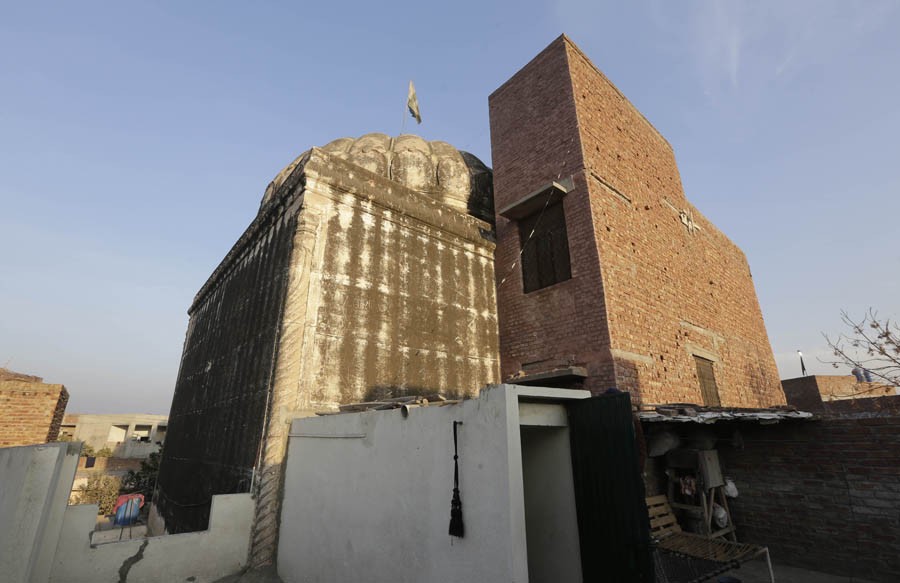
The last standing structure of the doomed Bhadrakali Mandir, in the vicinity of Thokar Niaz Baig, tells tales of lost glory, of craftsmen, and pride and piety

Before Lahore became the metropolis it is known today, it was a small city surrounded by settlements on the banks of the Ravi river. Among these settlements was the big fortified town of Niaz Baig (presently known as Thokar Niaz Baig).
It is said that Niaz Baig was conceived as an egalitarian community, established in order to realise a system of values with equal access to resources and to decision-making power. History has it that in the year 1748, when the Afghan King, Ahmad Shah Abdali, captured and ransacked the city of Lahore, the walls of Niaz Baig served as a refugee for people of nearby settlements who had come to the town fearing the Afghan King and his army.
Today, the town is part of the present-day Lahore but unlike its glorious past, Thokar Niaz Baig serves as an entry point to Lahore and a down-at-the-heels part of the city.
As in the rest of the country, due to the gradual theocratisation of the state, among the major fallouts at Thokar Niaz Baig since partition are the fast depleting sites of worship of the minorities.
Deep inside the congested locality stand the remains of what used to be a mandir (Hindu temple) in pre-partition days. Under the overcast sky, the Bhadrakali Mandir tells tales of lost glory, of craftsmen and pride and piety; today it stands brooding, mysterious, full of knowledge of yesteryears.
The Bhadrakali Mandir is unique as it is only a handful of temples within Pakistan dedicated to an incarnation of a female Hindu deity, one of the most impressive and formidable goddesses of the Hindu pantheon -- and one of the most popular -- the goddess Durga. The presence of the mandir associated with Durga, whose primary mythological function is to combat demons that threaten the stability of the cosmos, opens an unexpected door to the type of society living within the Niaz Baig back in the day. (‘Durga,’ in Sanskrit, means difficulty, a fortress, a place that is hard to conquer, like the walls of the old town.)
The Bhadrakali Mandir used to be a huge complex, with various stupas, two temples, a well with stairs leading to the base of it, an ancient Banyan tree, and a pool. Though, there is barely any historical reference found regarding the mandir or its history. Kanhiya Lal, in his book, documenting the history of Lahore, mentions the temple to have hosted the biggest Hindu festival in and around the city of Lahore.
It also seems clear that Durga has, at least at some point in her history, a close connection with the crops or the fertility of vegetation. It is believed that since Niaz Baig had an agrarian economy, the festival was held at harvest time, which may suggest the presence of Durga in Bhadrakali Mandir as a source of re-nourishment of her powers of fertility.
According to Lal’s account, the mandir used to have another huge structure with a dome made during the reign of Maharaja Ranjit Singh, and is said to be summoned by the King himself. The structure served as an extension of the mandir to house visitors, indicating the huge congregation that took place inside.
The temple complex where the festival would take place before partition was discontinued hence, the samadhs filled and removed from the memory of modern-day Lahore, the deep well that fed a huge pool lost.
The banyan tree mentioned in Lal’s account is also nowhere to be found, probably cut down to make room for another house in the congested locality. As the sun sets, the last standing structure of the Bhadrakali Mandir Complex, with its algae layered dilapidated walls, is lost in the cacophony of sounds coming from the vicinity of Thokar Niaz Baig. Within the inner sanctum of the mandir, where it is believed that the goddess Durga was placed for worship, an old guard locks the main door of the now Government Boys Primary School just in time for the call for prayers from the mosque next door.